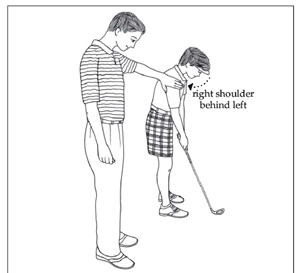Featured Golf News
Simplifying the Chip Shot

Have you ever stopped to wonder if the golf swing really needs to be so complicated - twist this, turn that, bend this, lift that? The answer is it need not.
In fact, the Minimalist Golf Swing is the least complicated swing a golfer can make, and it delivers the best possible results he or she is capable of. It is simple in its execution and scientific in its rationale, a strong combination which delivers the best possible results. It is suitable for any skill level of golfer.
The Minimalist Golf Swing - the Chip Shot
"The dog wags the tail, not the tail the dog." Ever since this little phrase became popular in golf a few decades ago, the entire nature of all small approach shots to the green has changed. It's become too complicated and often lacks consistency.

So to extend what has now become an axiom or universally recognized truth, does that mean that the entire dog must wag the tail merely to flick away that annoying fly at the tail's very tip? Surely not!
The chip shot can be considered a small move of the club back and past the ball, made in a very small time frame, certainly not long enough for the entire "dog" (the human body) to move in order to brush away a pesky "fly" (the golf ball).
A chip shot is one where the ball gets a little bit of height - just enough to land safely on the green, followed by a lot of run. The height is imparted by using a suitably lofted club such as a pitching wedge, and the run results from the golfer making a swing which keeps the club, and thus the ball, low throughout the swing.

The current style of chip shot requires the body to move the arms past the ball, resulting in a "stand-up-and-turn" type follow-through, not the easiest stroke to execute unless a golfer's timing is perfect.
Try these steps to the most basic of chip-shots, and see how your number of up-and-downs dramatically increase.
The Set-up (Southpaws: please reverse directions!)
A lofted club such as a pitching wedge works best.
Use a fairly narrow stance (feet perhaps 12 to 18" apart).
The feet should be parallel to the target line - creating a square, not open, stance.
Place the ball in the center or just slightly right of center of the stance.
The body should be more upright than for the full-swing.
Keep the elbows as close together as possible, without causing any tension in the shoulders.
Lean the left shoulder slightly towards target.
The right shoulder should be slightly behind the left shoulder, that is, slightly further away from the target line.
The Swing
The object of this shot-type is to keep the clubhead LOW as it arrives at and passes by the ball. This can only happen if there is no bend in either the wrists or the elbows.
Think of the arms as being two sticks which cannot bend. Move the "sticks" to the right, then past the ball to the left, and STOP where the stroke ends.
The clubhead should be no higher than 6" above the ground when you "hold-your-finish position."
Think "no wrist, no twist," which means no bending the wrists, no twisting the torso. In fact, each shoulder remains virtually on top of its own toe throughout the swing; it does not rotate away. The result is a clubhead movement which is practically parallel to the toes, never moving towards the left toe in the follow-through
The easiest way to succeed at this stroke is to 'swing past your nose" - let the arms and club move past the body, while the nose remains pointed at the ground.
The timing of the swing should be smooth, and the movement back and past, not at, the ball
Proof that You've Got it
Have someone stand behind you.
Pretend you have on a $30,000 wrist watch/bracelet.
If your stroke is correct you'll be showing off your wrist-adorning jewelry both on the backswing and the follow through; that is, your arms will clear the body on both sides!
Kiran Kanwar has 20 years experience as a golf instructor. She currently teaches golf in St. Louis, Mo., and in Bombay, India. At the 2008 PGA Merchandise Show Kiran exhibited a research-based golf swing that quickly gave players of any skill level better distance, direction and trajectory. She also has expertise in dramatically and rapidly increasing a golfer's swing-efficiency to preclude swing-related injury. She's a Class A teaching professional with credentials from the LPGA, the PGA (UK), the PGA of India, and the National Golf Academy of India. Among other titles, Kanwar won the Ladies All-India Open Amateur Golf Championship in 1983. A columnist for Golf Digest India, Kiran is the author of an instructional e-book - sold on her website - titled "DIY (Do-It-Yourself) GOLF." For more information visit www.yourgolfguru.com or email her at kk@yourgolfguru.com.
Story Options
 |
Print this Story |
